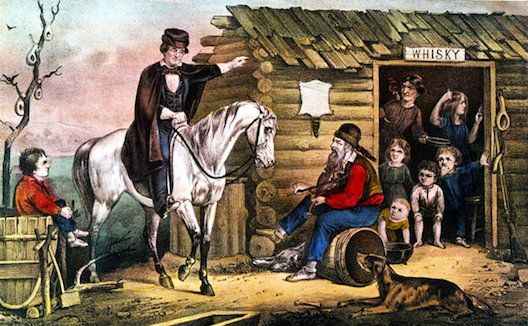The Story of the Arkansas Traveler

The Tale:
The Arkansas-connected version of the ―Traveler tale is said to have originated with Kentucky-born Sanford (or Sandford) Faulkner(1806-1874), a planter, banker and unsuccessful politician. During a political campaign of the early 1840s, Faulkner canvassed the outstate districts in company with several other politicians. In one version of the back story, the group included Ambrose Sevier, William Fulton and Archibald Yell and was traveling through the Boston Mountains, while a variant paired Faulkner with Albert Pike, deep in the woods of Yell County. In either version, the group lost its way and stopped for directions at a humble log home. What happened at the cabin is lost to history but Faulkner, a natural performer, turned the experience into an entertaining presentation for friends and acquaintances. In his recasting of the episode, a solitary Traveler is greeted by the Squatter at the log cabin with humorously evasive responses to his questions. Finally, the Traveler offers to play the second half, or ―turn, of the tune the Squatter has been playing on his fiddle; the tune is, of course, ―Arkansas Traveler. The Squatter is delighted at hearing the completed tune and throws open his household to the Traveler.
It is worth noting that at approximately the same time Faulkner began performing the ―Traveler, a similar song and related dialogue emerged outside the state. One cannot tell with certainty which version came first. In 1847, ―The Arkansas Traveller and Rackinsac Waltz, arranged by William Cumming, was published in Cincinnati OH. According to Thomas Wilson, writing in Ohio History in 1900, customers were attracted to the Golden Fleece Tavern in Salem, Ohio, by performances of the ―Traveller before 1852. Mose Case, an albino African-American humorist and guitar-player from Buffalo, New York, performed the Traveler; his version ended by declaring that the Traveler ―has never had the courage to visit Arkansas since! Case published―Arkansas Traveler sheet music in 1863 and his telling of the story appeared in two subsequent volumes. The routine was kept alive by vaudeville performers well into the Twentieth century and an Edison wax-cylinder recording of one such survives from about 1890.
The Tune:
- Download The Arkansas Traveler -— Format: MP3
- When ―The Arkansas Traveller and Rackinsac Waltz ―was published in Cincinnati in 1847, no composer was credited. This may indicate its origins in the folk tradition but at least one Ohio performer sometimes claimed composition honors: Marie de los Angelos Jose Tosso, sometimes known as Joe Tasso (1802-1886 or 1887), a Mexican born (of Italian parents) concert violinist, teacher and composer who lived in Cincinnati. Tasso, who had studied under Hector Berlioz, is reported to have been heard playing the melody as early as 1842. Several others, including Faulkner and Case and even artist Edward Washbourne (of whom more, anon), have also been credited with its composition. Perhaps the best verdict on its parentage was delivered by H.C. Mercer, writing in the March 1896 Century Magazine:
tIt really matters little where the (Traveler) » was born, whether in Yell County or in the
It really matters little where the (Traveler) » was born, whether in Yell County or in the
Boston Mountains; whether… it originated with Faulkner and his friends, or came from
the humor of Tasso. Like all true creations of fancy, it eludes definite description and
defies criticism, while the notes of the tune sound a gay disregard of boards of
immigration and State statistics.
The Arkansas Traveler
Lyrics by the Arkansas State Song Selection Committee, 1947
Music by Colonel Sanford (Sandy) Faulkner, about 1850
On a lonely road quite long ago,
A trav’ler trod with fiddle and a bow;
While rambling thru the country rich and grand,
He quickly sensed the magic and the beauty of the land.
Chorus
For the wonder state we’ll sing a song,
And lift our voices loud and long.
For the wonder state we’ll shout hurrah!
And praise the opportunities we find in Arkansas.
Many years have passed, the trav’lers gay,
Repeat the tune along the highway;
And every voice that sings the glad refrain
Re-echoes from the mountains to the fields of growing grain.
Repeat Chorus
Adopted by the 1987 General Assembly as the Official State Historic Song.
The Painting:
At some point in 1856, Arkansas artist Edward Payson Washbourne (1831-1860) completed a picture illustrating the meeting between the Traveler and the Squatter. In 1859, J. H. Bufford of Boston, Massachusetts published the image, rendered by lithographer Leopold Grozelier. On the print, the ―Arkansas Traveler melody line appeared below ―Designed by one of the natives and Dedicated to Col. S. C. Faulkner, implicitly identifying Faulkner as the author of the story. The Little Rock True Democrat (quoted by Sarah Brown in ―The Arkansas Traveller: Southwest Humor on Canvas [AHQ, 1987]) described the painting as ―a truly southern picture by a southern artist. Washbourne did not enjoy the painting’s fame long: he died in Little Rock after a sudden illness in March 1860. On his easel was a work in progress, a complimentary picture, ―The Turn of the Tune.
In 1870, New York print makers Currier & Ives brought out popular prints of the ―Arkansas Traveller and ―The Turn of the Tune with abbreviated dialogue, crediting neither Faulkner nor Washbourne. According to Little Rock resident G.H. Dodge, who claimed to have posed for Washbourne, the painter’s executors had another artist complete Washbourne’s unfinished work; this possible posthumous collaboration is not known to have survived. A painting believed to be Washbourne’s original of the Arkansas Traveler survives in the custody of the Arkansas History Commission.
* * *
References:
Bennett, Swannee. The Likeness Trade: Portrait Painting in Arkansas, 1780–1900. Exhibit catalog. Arkansas Territorial Restoration,1996.
Bennett, Swannee, and William B. Worthen. Arkansas Made: A Survey of the Decorative, Mechanical and Fine Arts, 1819–1870. Vol. 2.University of Arkansas Press, 1991.
Brown, Sarah. ―The Arkansas Traveller: Southwest Humor on Canvas. Arkansas Historical Quarterly 46 (Winter 1987) 348–375.
Hudgins, Mary D. ―Arkansas Traveler—A Multi-Parented Wayfarer. Arkansas Historical Quarterly 30 (Summer 1971) 145–160.
Masterson, James R. Arkansas Folklore: The Arkansas Traveler, Davy Crockett and Other Legends. Rose Publishing Co., 1974.
Lankford, George. ―The Arkansas Traveller: The Making of an Icon. Mid-America Folklore 10 (1982) 16–23.
Masterson, James R. Arkansas Folklore. Rose Publishing Company, 1974.
Mercer, H. C. ―On the Track of the Arkansas Traveller.‖ CenturyMagazine 5 (March 1896) 707–712.
Minton, John. 78 Blues: folk songs and phonographs in the American South. University Press of Mississippi, 2008
Smith, Ophia D. ―Joseph Tosso, The Arkansaw Traveler. Ohio History 56 (January 1947) 16–43.
Williams, Lindsey. ―Lindsey at large: Arkansas Traveler Skit First One Liners. Column, Charlotte (NC) Sun-Herald and Sun Coast Media Group. April 11 2004.
Wilson, Thomas. ―The Arkansas Traveller. Ohio History 8 (January 1900) 296–308.




